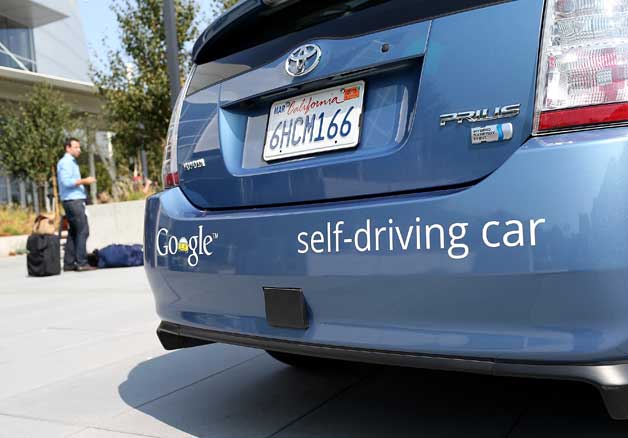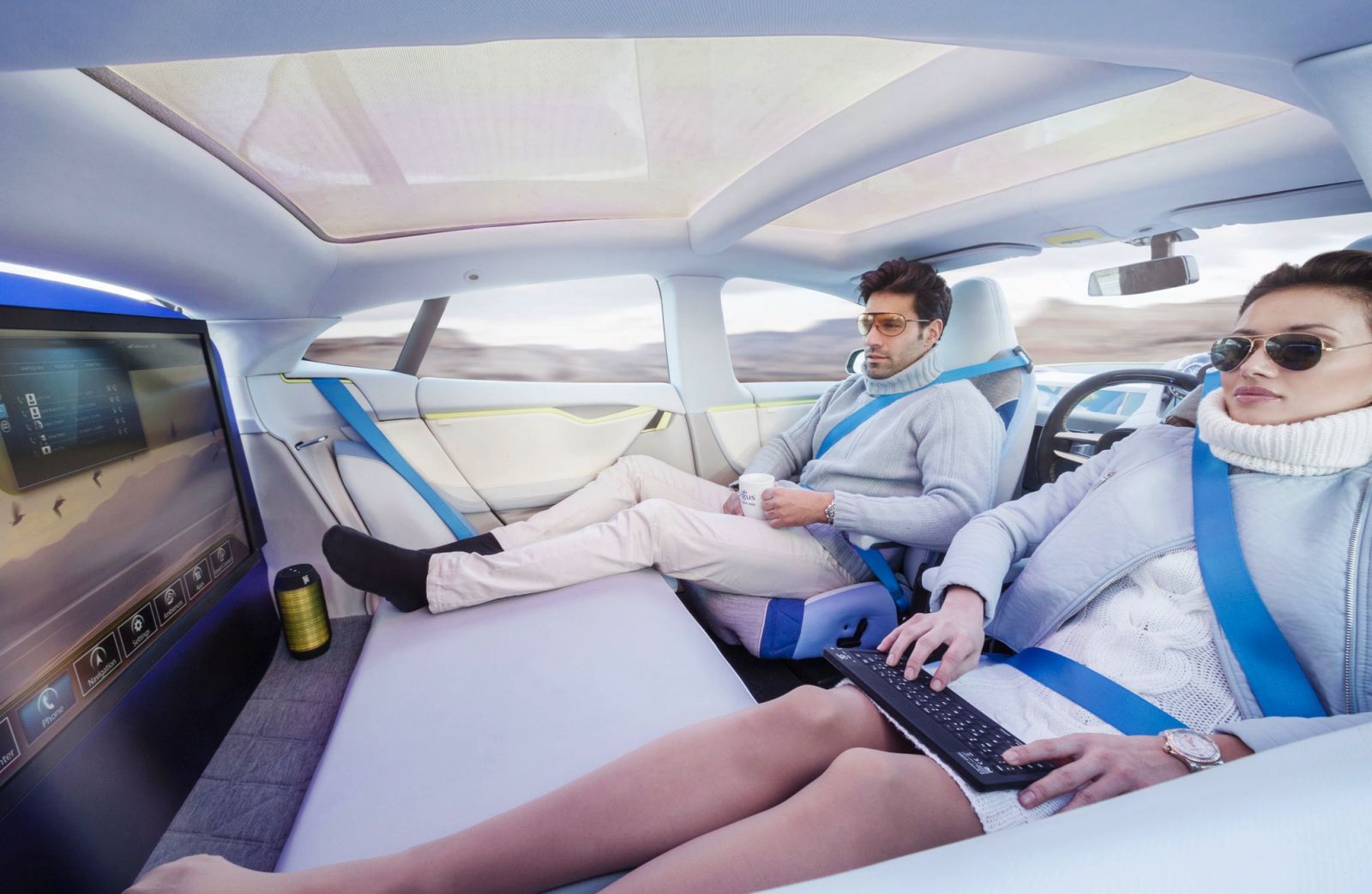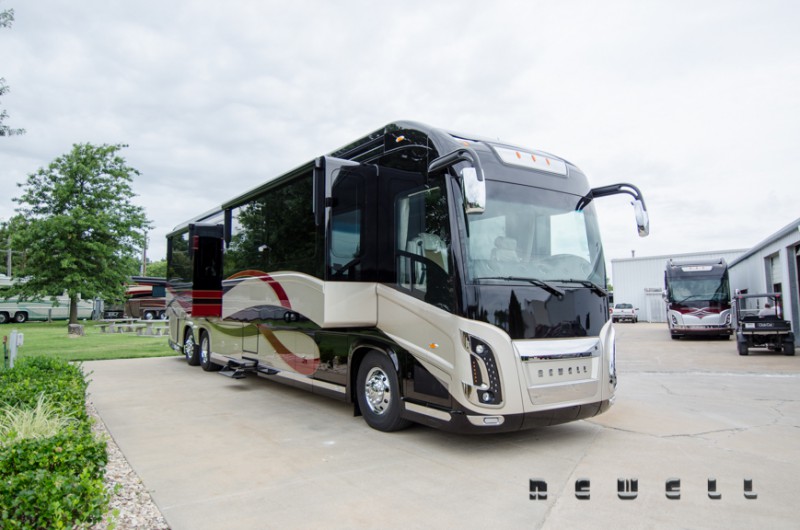
My April Fool’s experiment has taught me that most people simply do not click on links. 🙂 Accordingly, I’ll minimize the links on future posts, including this one, unless I feel it’s absolutely necessary. Heh.
In any event, back to semi-serious topics… and there’s a great one on LinkedIn by the one and only Glenn Kelman, CEO of Redfin (h/t: Inman News, which reposted it). (Okay, so I lied about not putting in links; I can’t help it — it’s part of the culture of blogging.) Kelman theorizes that the advent of the self-driving car will change the shape of real estate as we know it:
In our lifetimes, and the lifetimes of our mortgages, the self-driving car could change the shape of the American city even more profoundly. Unlike the cars of today, which are parked 96% of the time, self-driving cars will be in semi-continuous service except in the wee hours; we’ll need far fewer cars overall, and those that remain will leave town at night.
I agree that self-driving cars will change the shape of the American city even more profoundly. But I differ with Kelman in how they will do so; in fact, I think the exact opposite of what Kelman thinks will happen will happen.
Let’s dig in.
The City, According to Kelman’s Vision
Kelman’s basic hypothesis, backed up with good amount of research, is that after the advent of the self-driving car, we won’t need as many cars. That results in massive increase in the amount of land available for things other than parking. As he puts it, a third of urban real estate is devoted to parking, and 13% of a typical single family residential lot is devoted to parking.
He also points to research from Uber and Lyft that when people stop owning and driving cars, public transit use increases:
As cars become a service rather than an asset, proximity to bus lines may become less important, but subways and trains that can bypass car traffic altogether will only grow in popularity.
The vision of the City is something like a walkable series of neighborhood connected by both public transit (presumably into the high-trafficked urban cores where people have jobs) and cars-as-a-service that lets people easily move from one area to the other, along with commuter rail and public transit options for people to get into the City in the first place.
Kelman ends by noting some future-proofing suggestions, such as not paying a premium for a garage, paying a premium for proximity to subway or rail, and maybe buying that house/condo next to a giant parking garage, since in the future, that garage may be converted into a shopping mall. He ends with this:
A hundred years ago, the car was the reason that cities became something entirely different than villages, with sprawl, painful commutes and gated communities. Now the self-driving car may bring the old idea of a village back to the future.
Interesting vision, and one that could very well come to pass. But Kelman’s vision is a variation of the same vision of the Urbanist crowd for decades that place the City at the center of everything from the economy to social life to culture.
I tend to favor the new vision articulated most often by Joel Kotkin and crew over at NewGeography.com.
Conventional Wisdom Is Wrong
One of the more interesting things about the urbanist vision of society is that it’s flat out wrong.
For example, urbanists and the media would have us believe that the young, hip, sophisticated Millennials who all want restaurants and coffee bars and entertainment within walking distance are moving into cities. Here’s Nielsen for example, saying that Millennials prefer subways to driveways:
Millennials like having the world at their fingertips. With the resurgence of cities as centers of economic energy and vitality, a majority are opting to live in urban areas over the suburbs or rural communities. Sixty-two percent indicate they prefer to live in the type of mixed-use communities found in urban centers, where they can be close to shops, restaurants and offices. They are currently living in these urban areas at a higher rate than any other generation, and 40 percent say they would like to live in an urban area in the future. As a result, for the first time since the 1920s growth in U.S. cities outpaces growth outside of them.
But, where Millennials actually live is not in urban areas, but in suburbs. In May of 2015, the Urban Land Institute released a report called “Gen Y and Housing: What They Want and Where They Want It“. The findings are counter to conventional wisdom:
- Only 13 percent of Gen Yers live in or near downtowns; 63 percent live in the other city neighborhoods or in the suburbs.
- Eighty-three percent own automobiles (lowest percentage of owners, 74 percent, are in the Northeast; highest, 88 percent, are in the South).
Furthermore, the Millennials aren’t quite as urban-centric as people think:
A consistency between this survey and previous ones is that only 13 percent of the total sample lives in or near downtown areas. Therefore, even though in-town Millennials are much discussed by journalists, they are not representative of their generation as a whole. As shown in figure 1, when asked to describe themselves:
- 37 percent say they are “city people.”
- 36 percent identify as “suburbanites.”
- 26 percent are “small-town/country persons.”
Among the “city people,” three-fourths live in central-city neighborhoods outside downtowns. Even so, a significant contingent of “non-downtowners” is attracted to denser, mixed-use, walkable neighborhoods from which their commute will be short to moderate in length.
So 62% of Millennials identify themselves as either suburbanites or rural, and even the 37% who say they’re “city people” — 3/4 of them live outside the actual urban core.
In other words, only the most elite of the Elite Millennials have the kind of lifestyle that Kelman — who is without question among the most elite — envisions.
Edge Cities, Small Cities, and the New Population Growth
And Joel Kotkin has documented for years that despite conventional wisdom and the cheerleading of Big Cities, the real population growth has happened and is happening in smaller cities, edge cities, and suburbs. The top ten fastest growing cities from 2007-2012 look like this:
- New Orleans, LA
- Chula Vista, CA
- Irvine, CA
- Charlotte, NC
- Bakersfield, CA
- Fort Worth, TX
- Irving, TX
- Laredo, TX
- Greensboro, NC
- Austin, TX
And it isn’t just the less-educated, blue collar youths that are forced to move to these places because they can’t afford San Francisco and New York. The top cities for gaining college-educated residents are not San Francisco and San Jose (smack dab in the heart of Silicon Valley) but New Orleans, Raleigh, and Austin.
Without question, the main factor driving population growth in places like Irving, Raleigh, and Greensboro, NC is housing price. They’re just more affordable for everybody, which is particularly important for Millennials who are just starting to get into their careers.
It turns out that Millennials are not that different from Gen-X, from Boomers, from anybody else. When they’re young, they love the excitement of the Big City, the ease with which they can go out and party, walk home from bars late at night, meet up with their young friends for young people activities, and the like. Then they grow up and grow tired of the crowded, expensive big city living where they’re paying $3,000 a month for a tiny studio the size of most suburban bathrooms. They end up wanting the same things they grew up with: a safe neighborhood with tree-lined streets, white picket fence, a dog, and summertime BBQ’s in the backyard.
They’re not going to find that in dense urban cores. They’re going to move out to the suburbs.
What Will Actually Happen With Self-Driving Cars
Note once again that 83% of Millennials own a car. We could get into the importance of the automobile in the American cultural psyche, but we won’t. We don’t have to.
Because the bottomline is that it is human nature to want privacy, to want something of one’s own, rather than have to share with everybody else. Else, why even want a home? Why not just live in shared barracks-style housing?
The emergence of Uber and Lyft and so on has a lot of people thinking that they don’t need or want to own a car of their own. I think we’re looking at the wrong thing here. If the choice is between taking an Uber all the time or owning a car with its attendant costs (maintenance, gas, parking, etc. etc.) then sure, the Uber wins out. But if the choice is between an Uber and a private driver, not a lot of the super-rich choose Uber. For that matter, if the choice is between flying commercial and private jet, not a lot of the super-rich choose flying commercial with all of its limitations either.
The whole obsession with public transportation is also misplaced. Even in New York City, where public transportation is the most advanced of any city in North America, the wealthy take black cars from their brownstones in the Upper East Side to their office on Wall Street. They don’t deign to mix with the noisy, potentially dangerous, crowds in subways. The middle-class does, but not the Masters of the Universe types.
The thing about technology, though, is that it is most successful when it brings something that was once the province of the super-rich to the masses. Think about mobile phones, as an example. Or even the automobile itself: there were cars before Ford created the Model T, but they were expensive playthings of the very, very rich.
The self-driving car will finally bring to the masses what the rich already have: a personal driver.
In that world, is it really likely that people will forego the luxury of having a robotic personal driver that let’s them enjoy the lifestyles of the rich and famous? I doubt it. Human nature argues against it.
There is something about having “my” car that matters, even if all kinds of public or semi-public (self-driving cars) options are available. You can personalize your car with just the precise accessories and colors and even radio stations that you can’t with a shared vehicle. Even if self-driving cars will constantly be circulating and be available, there is something about not having to wait even five minutes for your ride: just get in your own self-driving car and tell it to take you home.
So what I think will actually happen is that self-driving cars will result in everyone replacing their family sedans with self-driving cars. A few driving enthusiasts will hold on to their sports cars, of course, but they’ll be using those for fun, not for transportation. Having replaced the family Toyota with a self-driving minivan, people will commute more not less. Why be stuck having to deal with the commuter rail schedule, if you don’t have to? Why deal with the crowds and the noise and oftentimes the smells of the subway if you don’t have to? I speak from years of personal experience living in NY/NJ area: there is nothing positive about rail-to-subway experience, except cost. Bring the cost down with self-driving cars, and it’s no contest — I’ll have my car drive me in to work and pick me up after work.
Consequences for Real Estate
To me, the impact on housing and real estate is exactly the opposite of what Kelman proposes. Cars will become more important, not less. Parking may very well disappear in expensive central urban cores since I will have the option of having my car drop me off at work, then drive itself home (or serve as an Uber for 8 hours to make some money, but that depends entirely on how nice my self-driving car is…), then present itself at the curb when I’m getting off work.
The biggest impact, I think, will be that the City will actually shrink even further. If commuting is no longer an hour of stop-and-go traffic when I can do nothing but listen to sports talk radio, but is instead an hour of time when I can fire up the 4G wifi and answer emails first thing in the morning, I may move even further away from the City. Why deal with the crowd, the crime, the traffic, the noise, the parts that suck about living in a city if I don’t have to? The time and distance of getting to the City is now productive time with self-driving cars. Why not get more land, more house, more peace and quiet and tranquility, for less money?
If the suburbs are where the action is today, in the post-autonomous car world, it may be the exurbs where the action is. I can buy a 3,500 sq.ft. house on 10 acres of my land with a swimming pool and a tennis court for the same price as a 1,000 sq.ft. 2BR condo in a high-rise with a neighbor who really likes to party? Sure, it’s 60 miles away, but that commute will be spent doing productive work, or reading, or just relaxing as my car drives itself? Is that even a real choice?
If I want to experience that whole walking-around-the-city while sampling a wide variety of restaurants and bars and such, hey, I guess I could have my car drive me in, I’ll do all the walking around I want, get good and wasted, and then have my car pick me up to drive me home, while sleeping (it’s a self-driving car; is there a need for car seats as we think of them today?) on the way home.

Therefore, my recommendations (which I suggest you ignore, since no one can predict the future) are these:
- Sell your expensive condo in downtown urban core, while the price is still high, and buy land out in the exurbs/country. Self-driving cars make those condos far less attractive to most people.
- Move out of the City as quickly as possible, since the coming decrease in the tax base as the population de-urbanizes thanks to the self-driving car, will result in some really “interesting” policies from our cities. See this story from today’s Chicago to get a sense of what’s ahead for most large American cities.
- Two-car garage may not be enough in the future, since self-driving cars mean your 9-year old can hop in a small self-driving pod to take himself to Little League practice, and your teen can motor herself to the mall, to her friend’s house, or to the movies without you having to drive them.
- Think about investing in parking facilities in urban cores, since well-to-do people aren’t likely to want their Mercedes-Benz 750GLE Self-Driving cars out and about in the streets picking up strangers who could be doing all kinds of weird things in their cars, or getting into accidents, or having birds poop on them, or whatever.
As for myself, if self-driving cars become the new reality… I might forego the home altogether and opt for a self-driving version of one of these:

Your thoughts, as always, are welcome.
-rsh


6 thoughts on “The City, Post Self-Driving Cars”
This kind of thinking is why we all love to read your blog …
Rob, I have to agree, young buyers, (what ever title/tag you give them) that I have been working with over the past two years do not want to move to cozy urban cribs.. they want land – and lots of it. They have been renting for up to 8 years and are tired of neighbors, noise and lack of privacy causing them to seriously take on crazy job commutes just so they can have some peace and quiet. And if you think it is because they have kids.. no, that is not the case – they are seeking elbow room to satisfy their own needs. Reading your blog today has shown me that perhaps my clients are not as unusual as first thought. I too would love a self driving RV… sign me up!
As is always the case, great overview Rob. I look forward to the day that Google empowers Lyft and Uber with such vehicles. Then I won’t be left standing on the curb outside my house trying to get a ride to the airport at 530AM and all of the drivers are asleep and all of their rides are in their garages! Onward.
SO
MUCH
YES!
“Two-car garage may not be enough in the future, since self-driving cars mean your 9-year old can hop in a small self-driving pod to take himself to Little League practice”
PLEASE & THANK YOU- said the mom of four boys
As a broker – one-person firm, dealing only with rural property,, I agree that more folks are moving out of the cities. They are willing to make drive to town. They want to escape – flee- from the cities for most of the reasons you mentioned.
But, as an oldster, I cannot wrap my thoughts around a self-driving vehicle. GPS gets lost in wilderness mountains. NAH! The self driving car (taxi) will not be major factor in people’s lives for 100 or more years or ever. Rob’s reasoning is good but fatally flawed: Large numbers of people will not give up their car. As for wrecks, who you gonna sue? “Wasn’t my fault, i wasn’t driving. Hell, sue the computer”. There’s just too many real world issues – flat tire 25 miles from town on dirt road – who you gonna call?
Comments are closed.